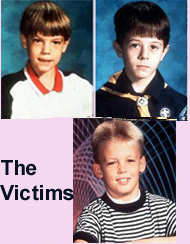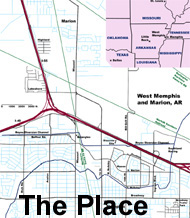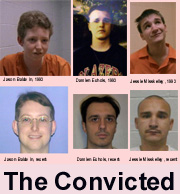Jivepuppi.com

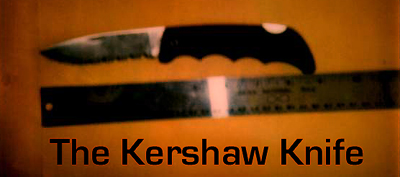
A Twilight Kill, Part Ten: More
late evidence
A bloody knife.
One knife that appeared at the trials had
blood on
it. Douglas Cooper, a cameraman for Home Box Office, was helping film a
documentary about the crime and the trials. Just as the film crew was
headed to New York to break for the Christmas holidays, Cooper was
presented a gift. "Rec[eived] knife on Sunday 12-19-93 late afternoon
from Mark Byers while at his residence. . . . Told him I didn't want
the gift couldn't understand why he gave it to me. He said it was
sharp. Cut a piece of paper. It's between us." [Cooper interview,
Gitchell notes, January 24, 1994]
The timing of the gift was disputed.
Mark Byers:
And uh, one of the man on the film crew from New York City, I think his
name is Kook, the one that had the camera I don't know if he's here are
not, but day when he was here we were talking about knives and he was
real friendly to me and I (inaudible) as a Christmas gift I gave it to
him, you know that all there was to it. If you ever want to see
it or anything he's in possession of it. I gave it to him as a
Christmas gift.
Inspector Gary Gitchell:
Alright when did you uh gave him that knife?
Mark Byers:
It was the last time they were down here which was uh, seem like they
were down here in November. [Mark Byers, January 26, 1994 interview
with police]
The timing was potentially significant. On December
20 the Byers house was searched - although only for fabric items that
might match. If Byers had a head's up on the upcoming search, he may
have wanted to relieve himself of evidence.
In New York, after seeing what might have been blood
on the knife, Cooper presented it to the directors of the documentary
who, after consulting with HBO lawyers, sent it to the West Memphis
Police. It arrived on January 8, 1994 and was then sent to Genetic
Designs Laboratories to determine whether the blood was human and, if
so, whether the blood could be linked to any of the victims. The blood
was found have the same HLA DQ-alpha type as Christopher Byers, and
shared by 4 to 9% of the population.
On January 20th, Gitchell sent a profile of Mark
Byers to the FBI agent Tom Self. Gitchell's notes of their
correspondence state that Self didn't believe Mark Byers was a likely
suspect. As for the knife:
Source and History of knife.
Wouldn't be unusual- him
playing with it + cutting himself + putting it back
Hopefully they can explain
the source [Gitchell's notes, Self conversation, January 22, 1994]
Self went on to recommend:
Interviews be simotaneous
[sic] - with Byers, Mellissa + Ryan [ibid]
Mark Byers and Ryan (but not Melissa) were
interviewed in the courthouse where the Misskelley trial was set to
take place on the day of the start of the Misskelley trial.
Ryan was interviewed first, by Detective Ridge. Ryan
explained where the knife was kept and how it was accessible to Chris.
However, Ryan stated that he never saw Chris with the knife and that
Chris never played with knives.
Ryan: No, we...he [Mark Byers]
always, he always kept it in his room, we never did mess with it.
Ridge: Okay, Mark kept it in
his room?
Ryan: Um hum.
Ridge: Okay.
Ryan: Or he kept it by his
chair [in the den]. [Ryan Clark interview, January 26, 1994]
[snip]
Ryan: I never did see him
[Chris] mess with it. He never did mess with knives. He never
did. [ibid]
Ryan said that his stepfather, Mark Byers, used the
knife while hunting.
Ridge: Did he [Mark Byers] use
the knife when he went hunting?
Ryan: Hey, he used to carry it
around on his belt whenever he went hunting. [ibid]
The interview with Mark Byers was high stakes. From
the perspective of the police there was blood on the Byers knife that
matched the victim Chris Byers just at the start of the Misskelley
trial. The police were still waiting on the lab results from the other
family members. Mark Byers began by stating the knife had never been
used and kept in his dresser.
Mark Byers:
. . .no that knife had not been used at all, it just been kept up, put
in my dresser and I didn't use it and the reason why was is because of
those serrated edges.
Gitchell: Uh-huh
Mark Byers:
You couldn't keep it sharp, and he thought it was neat because it had a
Velcro case that you could carry it on your belt with, and it kinda had
a grip on it that felt like pachmayr's on a gun, and he just really
like it and admired it and I really didn't like it so I gave it to him
[Cooper].[Mark Byers interview, January 26, 1994]
Mark Byers repeated Ryan's assertion that Chris did
not play with knives and that no one had been cut by this knife.
Gitchell: Um, did, did any of
your sons ever play with the knife?
Mark Byers: Uh, Christopher
never played with knives that I knew about or saw
[snip]
Mark Byers: Correct no ones
been cut with the Kershaw
[snip]
Mark Byers: ...that
Karshaw stayed put up in a top of my chiffarrobe in the top drawer we
got a big chiffarrobe you know and it stayed put up in the top drawer
of it [ibid]
Ridge, arriving after the start of the interview and
having been told by Ryan that the knife was also kept in the den by
Byers' chair, offers Mark Byers an out.
Ridge: Is there a period of
time that this knife may have been kept in the den by your chair?
Mark Byers: It seems like
when I first got it I trimmed on my finger nails some with it right
there under the lamp.
Ridge:
Now, you say when you first got it, is that just that particular day it
may have been there or could it have been there for a period of time?
Mark Byers: Possibly a day or
two. [ibid]
Then Gitchell dropped the first bombshell.
Gitchell: And you need to
answer this for me, we have found blood on this knife
Mark Byers: I can tell you
where I might assume it might have come from
Gitchell: Alright
Mark Byers: Uh, I got a deer
this year [ibid]
And then the second bombshell, the blood was human
and matched Chris. Mark Byers answers were adamant and repeated.
Gitchell:
Okay, Alright, let me, let me go on a little bit further and say
there's a problem with that, I mean I'm not saying that's not true, the
problem is we have sent this knife off and had it examined and it has
the blood type of Chris on it
Mark Byers: Well Gary I don't
have any idea how it could be on there
Gitchell: That's our problem
Mark Byers: I have no idea how
it's on there
Gitchell: Why, why would this
knife have his blood on it?
Mark Byers: I have no idea Gary
Gitchell: That's what scares me
Mark Byers: I have no idea, I
have no idea, how it could have any human's blood type on it at all
Gitchell: (inaudible)
Mark Byers: I don't even
remember nicking myself with it cutting the deer meat or anything
[ibid]
Remarkably, Detective Ridge summed up the interview
as "Byers stated he had cut himself with the knife..." [Detective
Ridge report, January 26, 1994, John Mark Byers interview]
The next day, January 27, Genetic Designs released
its analysis including other members of the Byers household. The
blood on the knife not only matched Chris Byers' type, it matched that
of his stepfather, Mark Byers (they are unrelated and the match was
improbable). The findings regarding the knife and Mark Byers statements
were not made available to the defense for the Misskelley trial, a
point argued in his attorney's appeal. In the Echols/Baldwins
trial defense attorney Val Price questioned Byers about the
knife.
Price: Alright, well the place
that the - where did ya'll keep the knife in your house?
Mark Byers:
When I first received the knife, which was for [a previous] Christmas,
uhh - for a few weeks it was in the living room on a little end table
by my recliner. And then after that, it was put in my bedroom on the
dresser. [Mark Byers testimony, Echols/Baldwin trial]
[snip]
Price: ...Did you have any idea
how human blood was on that knife?
Mark Byers: Well yes I would
have an idea, I cut my thumb. [ibid]
Mark Byers
attempted to explain the discrepancies between his testimony and the
January 26 interview.
Mark Byers:
When he was referring to that of why would this knife have any blood on
it, I was under the assumption that he was talking about Christopher's
blood on it, which like I said, I didn't have any idea. He didn't ask
me was there any way that any other type of blood or it's substance
could have been on there because just a paragraph or two up before
that, I told him where I was trying to cut the venison with it.
Price:
On the top of page 8, do you recall being asked the question, "I have
no idea, no idea how it could have any human blood on it." You recall
giving that answer?
Mark Byers: Yes sir.
Price:
And then it's inaudible from Gitchell and then do you recall stating,
"I don't even remember nicking myself with it, cutting the deer meat,
or anything." Is that the answer you gave?
Mark Byers: Yes sir.
Price: And is that the truth?
Mark Byers: I, at the time when
he was questioning me, I didn't re - I mean, I might not have
remembered. . . [ibid]
Was there ever a knife?
As part of their re-examination of
evidence in
the appeal of this case, the defense team of Echols and Baldwin have
brought together a formidable collection of medical forensic experts
with decades of experience, including the authors of the standard
textbooks in the field of forensic pathology. This group included
forensic pathologist Drs. Werner Spitz, Michael Baden, Vincent Di Maio,
Richard Souviron, Terry Haddix and Robert Wood. "The consensus reached
by all of those experts was again, that most of the injuries to the
skin of the victims, including the severe genital injury to Christopher
Byers, were not caused by the use of a knife but by animal predation
that occurred after death." [November 1, 2007 Legal Defense Team Press
Conference.] Dr. Spitz was more emphatic. "None of the injuries were
caused during life, and none were caused by a serrated knife, or any
knife for that matter. These are not sharp injuries that have
characteristics, and those characteristics are not identifiable or
synonymous with a knife or any other sharp force type injury. . . I
couldn't understand what this issue was all about because it was so
obvious that these are animal product." [Dr. Werner Spitz, ibid]
Spitz suggested his conclusions were basic and
beyond dispute. The signature of wounds taking place after death are
different from those that occur during life. Blood was noted escaping
from Moore as he was recovered from the water - also suggesting
a recent wounding. The conclusion that there never was a knife was
another blow to Misskelley's
account was in error and made the great drama over knives moot.
Was it a twilight kill?
In the Echols/Baldwin trial, the medical
examiner, Dr. Frank Peretti, described the phenomenon of lividity.
Peretti:
Lividity is the postmortem settling of the blood into the capillaries
in the blood vessels which have lost their tone after death. [snip]
Lividity goes through different stages, okay. What we have - we have
lividity which is called unfixed. Then we have lividity that is fixing
and lividity that's fixed. Ok, now unfixed lividity means up to a
certain period of time if someone dies on their back - ok, up to normal
environmental conditions, if I was to die in this room right now and I
was lying on this floor - for say eight to ten hours, all my blood
would settle to the back of the body. Now, if you were to examine my
body - say two hours after I die, the lividity - if you were to touch
it with your finger, it would blanch. In other words, you would be able
to push the blood out of the blood vessels. So it is called blanching.
But if I was to still be the floor and um - around eight hours, you
would come and you would press the lividity, you would see it's fixing.
It is in that stage where it is beginning to fix and unfix. And fixed
lividity is when you go there - you know, no matter how much you press
it, it is going to stay in that one spot. [Dr. Frank Peretti,
Echols/Baldwin trial]
In the case of the victims, the lividity was noted
by the coroner at four p.m. and blanched to the touch, suggesting death
less than ten hours before the finding. The defense went on to ask
Peretti about his estimation of the time of death.
Ford:
I'm asking you to tell this jury, in your opinion - in your opinion,
based on what you have read, what is your opinion as to the time of
death? What time? [ibid]
After stating that he could only offer a range of
times, he answered.
Peretti:
Well, based on what I know, it would be um - as a very, broad range -
between one and, one a.m., and you know, five to seven in the morning.
[ibid]
This was problematic for the prosecution. Their
theory of the case centered around the children being murdered in the
woods early in the evening. The area had been searched that night.
There would be no imaginable reason for them to appear in the
mosquito-infested woods in the early hours of the morning. A five a.m.
time of death meant the bodies were dumped in the ditch. The defense
went on to inquire about the factors that went into Peretti's
conclusion. These included
Ford: And Doctor, did you also
take into consideration your experience?
Peretti: Yes sir.
Ford: And all of the knowledge
that you have gained over the years of being a pathologist.
Peretti: Yes sir.
Ford: The air temperature.
Peretti: Yes sir.
Ford: Ok. You took that into
account. You took into account the water temperature?
Peretti: Yes sir.
Ford: Took into account when
they disappeared?
Peretti: Yes sir.
Ford: Took into account when
they were found?
Peretti: That`s correct.
Ford: Took into account the
cause of death?
Peretti: That's correct.
Ford: Took into account the
manner of death?
Peretti: That's correct.
Ford: Um - you also indicated
that you had um - two other doctors that you worked with?
Peretti: Yes.
Ford: Ok. And did you discuss
your opinion with them?
Peretti: We discussed it.
Ford: Ok. And do they concur
your opinion?
Peretti: Uh - they're in
agreement. [ibid]
The prosecution brought in a witness to repair some
of the damage, Dr. Duke Jennings. Jennings, a local pathologist, had
three months training in forensic pathology. He testified to having
read Peretti's testimony that morning and concluded that the time of
death estimate was weak. His reasoning included,
- The general
opinion of pathologists and literature sources is that lividity is the
worst possible measurement of time of death.
- The bodies may
have been rocking or rotating in the water.
- The water
temperature was listed as approximately 60 degrees rather than an exact
figure.
- Bleeding to death
could change the blanching.
- Rapidly cooling
in water could change the timeframe for onset of lividity.
- Jennings claimed
Dr. Peretti did not take into account water or air temperature.
- The position they
were found in the water was unknown.
- The movement of
the bodies after recovery could change lividity response.
- The coroner
didn't arrive until awhile after the bodies were recovered.
- The coroner
didn't take
body temperatures or test for rigor mortis. [Derived from the testimony
of Dr. Duke Jennings, Echols/Baldwin trial]
Some of
these
are relevant. It is certainly the case that time of death
determinations are far from precise. Others such as the possibility of
the children rotating in the water are ridiculous and irrelevant to the
case. Furthermore, Peretti did acknowledge taking into account water
and air temperature, cooling, and did testify to consulting with two
other professionals.
Misskelley's attorney was livid. As with the Kershaw
knife, the estimation of the time of death came too late to help his
client.
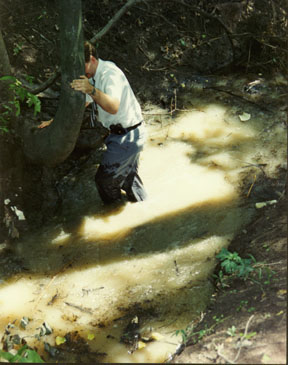
Det. Mike Allen in the creek just before the discovery of the victims.
The water temperature
and whether the victims were rotating in the water
were
suggested as possible confounders in determining the time of death.
Continued in A
Twilight Kill, Part Eleven: DNA.



